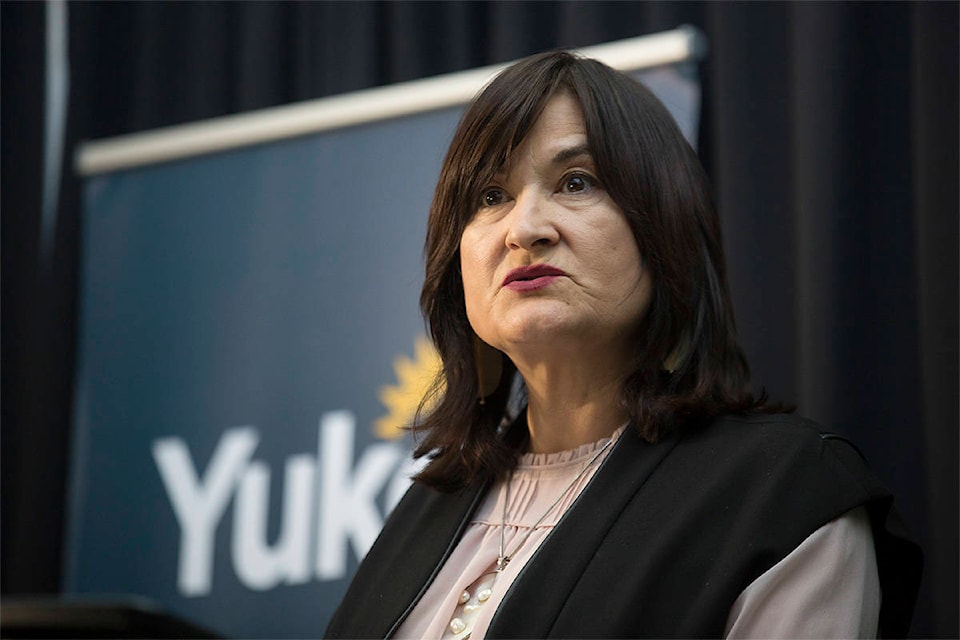There have been 15 opioid-related deaths in the Yukon since 2016, 11 of which involved fentanyl, the chief coroner told the News.
One of those deaths occurred in 2018, said Heather Jones. She would not speak to specifics, citing a wait time for results.
“Our toxicology is better than it had been, but I’m still waiting four months for results, so that makes it hard to be really current with trends,” she said. “But, absolutely, any of these deaths are a concern.”
The four-month period is standard across the country, Jones said.
On a per capita basis, the Yukon ranks third across the country as having the most opioid-related deaths, she said — first is British Columbia; second is Alberta.
The territory began keeping track of statistics in 2016. It was this year that the first fentanyl death occurred in the Yukon, Jones said.
The issue was raised during question period on Oct. 15 with NDP House Leader Kate White asking why there’s been radio silence on the file since January and what the government intends to do to fix the problem.
“There is an opioid crisis across Canada and, Mr. Speaker, there is an opioid crisis in Yukon, but we aren’t talking about it,” she said.
White had inaccurately stated that the Yukon has the second highest opioid-related death rate in Canada. The territory is, in fact, third on that list.
Health and Social Services Minister Pauline Frost responded by saying that her department is working with its partners across the country to address the issue, noting that 1,200 naloxone kits have been provided since 2016.
“We have worked with our partners, as noted, to look at identifying a prevention coordinator overseeing the ongoing distribution, inventory and training. We’re working with Blood Ties Four Directions and other stakeholders in our community,” she said.
Blood Ties, a community health organization, has a drug-testing program that can screen for drugs laced with fentanyl.
“My department has supported an establishment of four opioid working groups focusing on harm reduction, public awareness, surveillance and health and social system reform. The action plan that we have been working on with our partners is now actively being implemented,” Frost said.
Speaking to reporters following question period on Oct. 16, Frost was asked why safety bulletins haven’t been sent out when there’s a bad batch of drugs on the streets. Frost didn’t directly answer the question.
“I would say that we’re already doing that,” she said. “We’re working to promote and get the materials out. … we’re trying to hit the high-use areas.”
Frost confirmed that two positions to help curb opioid overdoses were established.
Department spokesperson Pat Living said both jobs have been filled.
There has been an opioid overdose prevention coordinator for “at least a year.”
“She’s been doing a lot of our naloxone and education awareness activities,” Living said.
There’s been an opioid surveillance officer for about 10 months.
Frost said her department is working with the chief medical officer and has a strategy to mitigate the problem.
“We’re rolling that out. We are just signing off an agreement with the federal government to provide support to Yukon to the tune of $500,000 to help us to stabilize, get out as much as we can, and create the supports that are needed for our communities,” she said. “We need to look at the whole of health care, of adjusting our models of care.
“I don’t want to say we’re hanging it on two positions, because that’s not going to fix anything,” Frost added.
Tracy-Anne McPhee, the education and justice minister, said the government is working with students and families to inform them of the risks of illicit drugs.
It’s unclear how the department is going about this.
“(W)e have to get the message out to young people and to everyone in the territory that drug use of almost any kind can be dangerous — more dangerous than ever before — because of the use of fentanyl and the consideration of fentanyl being included in these kinds of things,” she said.
Contact Julien Gignac at julien.gignac@yukon-news.com
